Powdery Scab of Potatoes (PP1891, June 2018)
Availability: Web only
S. subterranea is able to survive a range of environmental conditions via resting spores arranged in aggregates (sporeball, cystosorus; Figure 1A). Once the pathogen has become established in a field, it can remain infectious for more than 10 years in the absence of potatoes.
A.
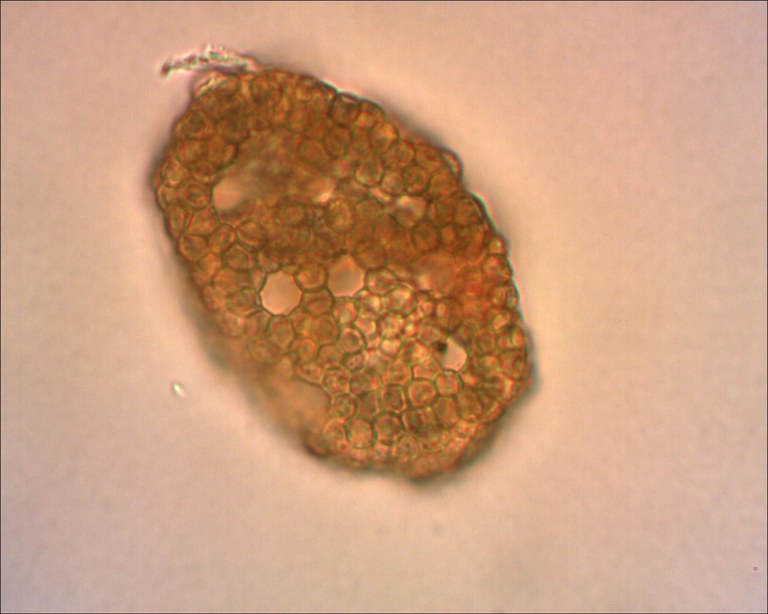
B.
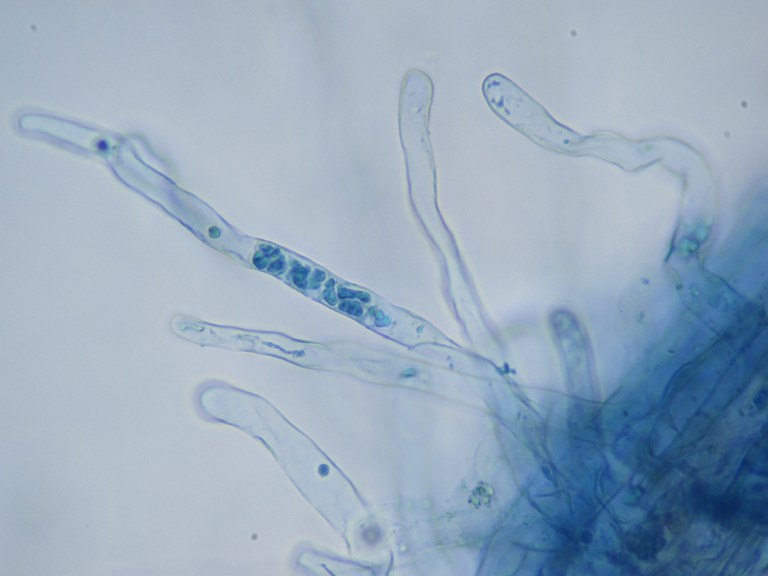
Figure 1. A. Spongospora subterranea (powdery scab pathogen) resting spore aggregate (sporeball, cystosorus). A single sporeball can contain more than 500 resting spores. Zoospores are released from the sporeball in a staggered manner. B. Initial infection by S. subterranea occurring in potato root hair. Zoospores released from initial infections may re-infect host roots or spread the pathogen to stolons and tubers. (F. Bittara, NDSU)
The likelihood of powdery scab developing remains high for up to five years after potatoes are grown in the field. Cool (53 to 63 F) and moist soil conditions (from soil saturation to about 15 percent water content) are conducive for disease development, especially if those conditions are met during the early stages of tuber development.
Powdery scab directly affects the quality of the crop intended for fresh, processing and seed markets. Resting spores produced on tubers and in roots contribute to inoculum buildup, pathogen spread and disease perpetuation in the field.
S. subterranea causes important economic loss in the cultivated potato (Solanum tuberosum ssp. tuberosum); however, the pathogen can infect and produce viable resting spores in other members of the Solanaceae family such as nightshades (S. nigrum and S. physalifolium).
The germination of S. subterranea zoospores (swimming spores) from resting spores (Figure 1A) is stimulated by root exudates of several plant species, as well as micronutrients (for example, iron) commonly found in soil solution. Zoospores released into the soil initiate the disease process by infecting the root hairs of the host plant (Figure 1B); this infection cannot be seen with the naked eye.
Once in the host tissue, the pathogen undertakes several inoculum-producing cycles (polycyclic), thus increasing and spreading the infection in the plant. S. subterranea is one uncommon example of a polycyclic soil-borne pathogen. In addition, this pathogen is the vector of the Potato mop-top virus (PMTV), another pathogen of economic importance in the U.S. and other potato-growing regions across the world.
Symptoms
On tubers, initial powdery scab symptoms appear as purplish-brown lesions that later develop into small blisters occurring as early as 43 days after planting (Figure 2A). Mature symptoms appear as round, slightly raised and usually shallow lesions (1/16 to 1/4 inch in diameter), which may show raised margins (Figure 2B).
Individual lesions may coalesce, increasing the area of the tuber affected by the disease and exposing masses of resting spore aggregates. In some instances, mature lesions do not burst open, appearing as dark, raised lesions (Figure 2C).
Root galls caused by S. subterranea initially are creamy white (Figure 2D) and turn dark brown when they mature (Figure 2E). Root galls vary in size (1/16 to 7/16 inch in diameter) and may appear as soon as 35 days after planting and develop throughout the growing season.
Russet-skinned potato cultivars are, in general, resistant to powdery scab. However, their susceptibility to root gall formation may not be related. Based on field studies conducted in North Dakota and Minnesota, red- and white-skinned potato cultivars are more susceptible to potato powdery scab and root gall formation as a group, compared with russet- and yellow-skinned potato cultivars.
A.
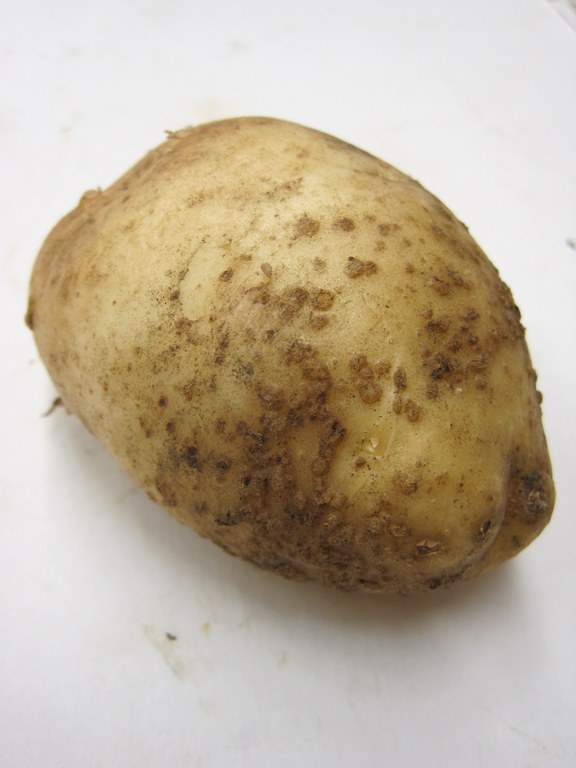
B.
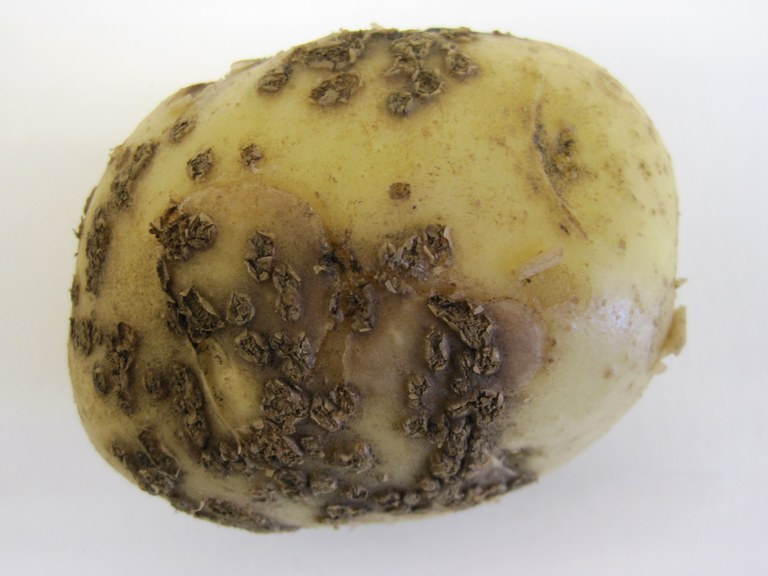
C.
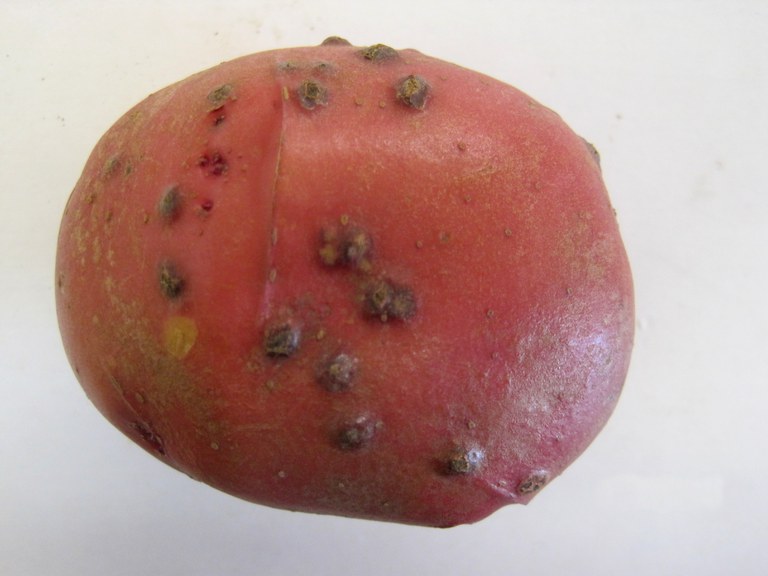
D.
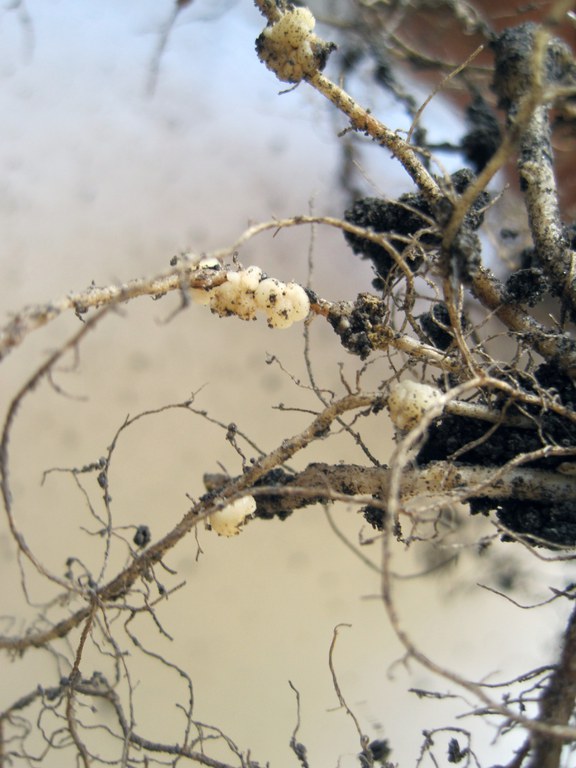
E.
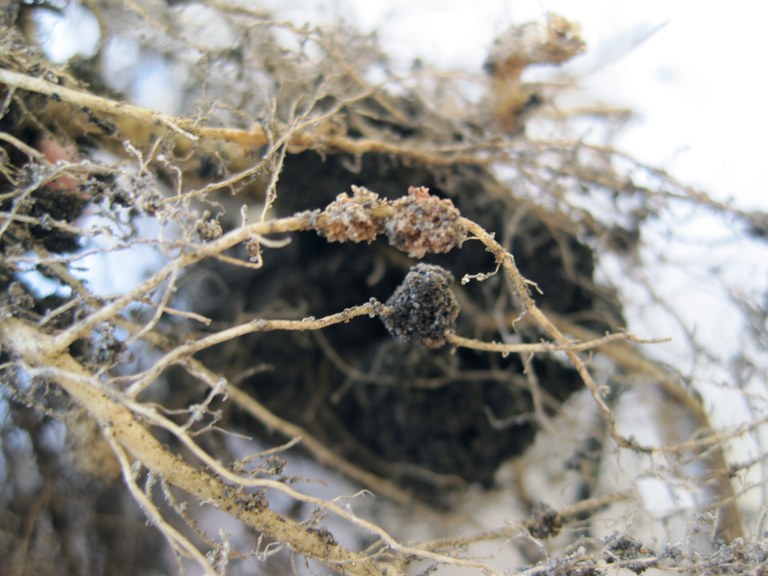
Figure 2. Spongospora subterranea symptoms on tubers (powdery scab) and roots (root gall formation). Powdery scab lesions start as small blisters (A) and turn into open, circular lesions often exposing masses of resting spores arranged in aggregates (B). In some instances, mature lesions may not burst open and appear as dark raised lesions (C). Root galls caused by the pathogen are creamy white (D) and dark brown at maturity (E). (F. Bittara, NDSU)
The relative level of susceptibility of 29 potato cultivars is presented here (Table 1). However, producers should consult a plant pathologist if the level of resistance of a particular potato cultivar not shown.

Management
The management of diseases caused by S. subterranea is difficult largely due to the nature of the pathogen. We recommend producers start with field selection and the adjustment of management practices.
Planting clean seed into clean soil is a good beginning. Disease symptoms may increase or be exacerbated under waterlogged soil conditions and under excessive nitrogen levels. The amount of nitrogen also may increase the amount of inoculum returned by the pathogen to the soil. In addition, planting wheat prior to potatoes may increase the severity of symptoms.
In the U.S., fluazinam (Omega) is registered for the management of disease in roots and on tubers. Fluazinam applied in-furrow at planting may offer 20 to 40 percent disease suppression. Chloropicrin soil fumigation is effective at reducing S. subterranea inoculum in soil; however, it may exacerbate disease in roots and on tubers of susceptible cultivars (Table 1).
In addition, seed-potato tolerances to powdery scab, along with potato common scab, are included in the “scabs” category. The latter is caused by the bacteria Streptomyces spp. and usually develops under suboptimal (dry) soil moisture conditions.
To manage disease caused by S. subterranea, we recommend producers:
- Use powdery scab-free seed potatoes*
- Not plant powdery scab-infected seed potatoes into S. subterranea-free soils*
- Avoid planting in S. subterranea-infested soils*
- Avoid excessive nitrogen fertilization
- Avoid planting in soils with poor drainage capacity
- Sanitize field equipment and implements after working in S. subterranea-infested soils
- Not use manure from cattle fed with powdery scab-infected tubers
- Plant resistant potato cultivars
* The authors recommend interested parties contact the NDSU Plant Diagnostic Lab to determine the presence of S. subterranea resting spores on tubers and in soil. For more information, the NDSU diagnostic lab can be reached at:
NDSU Plant Diagnostic Lab
Waldron Hall, Room 206
Fargo, N.D.
Telephone: 701-231-7854
Selected References
Bittara, F.G., A.L. Thompson, N.C. Gudmestad and G.A. Secor. 2016. Field evaluation of potato genotypes for resistance to powdery scab and root gall formation caused by Spongospora subterranea. American Journal of Potato Research 93: 497–508.
Bittara, F.G., G.A. Secor and N.C. Gudmestad, 2017. Chloropicrin soil fumigation reduces Spongospora subterranea soil inoculum levels but does not control powdery scab disease on roots and tubers of potato. American Journal of Potato Research 94: 129-147.
Falloon, R.E. 2008. Control of powdery scab of potato: towards integrated disease management. American Journal of Potato Research 85: 253–260.
Merz, U., and R.E. Falloon. 2009. Review: powdery scab of potato - increased knowledge of pathogen biology and disease epidemiology for effective disease management. Potato Research 52: 17–37.

June 2018

